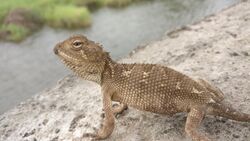Biology:Hardwicke's bloodsucker
| Hardwicke's bloodsucker | |
|---|---|

| |
| Scientific classification | |
| Domain: | Eukaryota |
| Kingdom: | Animalia |
| Phylum: | Chordata |
| Class: | Reptilia |
| Order: | Squamata |
| Suborder: | Iguania |
| Family: | Agamidae |
| Genus: | Calotes |
| Species: | C. minor
|
| Binomial name | |
| Calotes minor (Hardwicke & Gray, 1827)
| |

| |
| Synonyms | |
|
Agama minor Hardwicke & Gray 1827: 218 | |
Hardwicke's bloodsucker (Calotes minor) is an agamid lizard and found in South Asia.
Morphology
Physical structure: This is a small stocky and pot-belly lizard with a short tail. Its head large and elongated, flat above, sloping towards snout.[2] Its dorsal scales larger, strongly imbricate and keeled, pointing backward and upward, ventral scales smaller than dorsal; upper head scales larger, unequal, strongly keeled or tubercular.[3] Females are larger than the males.[1]
Color pattern: Dorsal color is olive-brown with three rows of dark-brown light edged spots on the back and base of the tail; spots of middle row are most prominent and rhomboidal; a white streak on each side of the neck is bifurcating behind and an oblique one from the eye to the angle of mouth; limbs are with dark-brown cross bars; throat is profusely spotted with dark-brown and orange; belly is yellowish-white with numerous orange dots.[3] Color inside the mouth is ink-blue.[4] Females are more brilliantly colored during breeding season.[1]
Length: Maximum:18 cm,[2] Common:10 cm. (Snout to vent 6 cm.)[2]
Distribution
Found in Bangladesh (southeast part of the country), India (Madhya Pradesh, Uttar Pradesh, Rajasthan, Gujarat, Odissa) and Pakistan (Sindh).
Vernacular names
Bengali: আগামা গিরিগিটি, পাতি রক্তচোষা, পাতিয়াল গিরিগিটি (Patial girigiti), হার্ডউইকের গিরিগিটি।
English: Hardwicke's bloodsucker, Hardwicke's short-tail agama, dwarf rock agama, and lesser agama.
Hindi & other Indian languages: ?
Urdu & Sindhi: ?
Habitat
This lizard is terrestrial and sometimes arboreal; inhabits frequently fragmented dry forest, arid environments, barren desert and desolate areas across the Indo-Gangetic plains.[1]
Habit
This lizard is diurnal and crepuscular. It shelters in burrows close to the roots of thorny bushes.[1] Generally it is found sitting on stones, but it can climb up shrubby vegetation. It is sluggish in movements, often not attempting to escape when approached.[3] It is a docile species.[5]
Diet
This lizard is mainly insectivorous; feeding on grasshoppers and their nymphs, earwigs, beetles, bugs, arthropods and spiders.[3] Sometimes it also eats flowers.[1]
Reproduction
This lizard is oviparous; the breeding season extends from April to June; it lays four to six hard shelled white eggs in burrows under the roots of vegetation.[1]
Importance and uses
There are no known practical uses of this species, but it plays a role in the eco-system by eating various types of insects and otherwise.
Threat to humans
This lizard is non-venomous and completely harmless to humans.[6]
Etymology
The species-name minor, a Latin word, meaning 'less' or 'smaller', also referring to the smaller size of this agamid.[7]
Extra notes
This lizard has a reputation for being particularly harmful, which is totally baseless and has contributed much to its depletion.[1]
References
- ↑ 1.0 1.1 1.2 1.3 1.4 1.5 1.6 1.7 Mohapatra, P., Srinivasulu, C., Thakur, S. & Vyas, R. (2021). "Calotes minor". IUCN Red List of Threatened Species 2021: e.T170377A127896966. https://www.iucnredlist.org/species/170377/127896966. Retrieved 20 November 2021.
- ↑ 2.0 2.1 2.2 [1] [|permanent dead link|dead link}}]
- ↑ 3.0 3.1 3.2 3.3 "Madhya Pradesh State Biodiversity Board". 24 October 2017. http://snakes.mpsbb.info/33.html.
- ↑ [2] [|permanent dead link|dead link}}]
- ↑ "Handbook Indian Lizards". http://faunaofindia.nic.in/PDFVolumes/hpg/007/index.pdf.
- ↑ "Fauna of West Bengal". 1992. http://faunaofindia.nic.in/PDFVolumes/sfs/007/index.pdf.
- ↑ "Etymology of minor". https://www.google.com/search?q=Etymology+of+minor+.
Sources
- Blyth, E., 1856, Proceedings of the Society. Report of the Curator. J. Asiat. Soc. Bengal 25:448-449
- Boulenger, G.A., 1885, Catalogue of the Lizards in the British Museum (Nat. Hist.) I. Geckonidae, Eublepharidae, Uroplatidae, Pygopodidae, Agamidae. London: 450 pp.
- Boulenger, George A., 1890, The Fauna of British India, Including Ceylon and Burma. Reptilia and Batrachia. Taylor & Francis, London, xviii, 541 pp.
- Günther, A., 1864, The Reptiles of British India. London (Taylor & Francis), xxvii + 452 pp.
- Hardwicke, F.R. & Gray, J.E., 1827, A synopsis of the species of saurian reptiles, collected in India by Major-General Hardwicke. Zool. J. London 3: 214-229
- Manthey, U. & Schuster, N., 1999, Agamen, 2. Aufl. Natur und Tier Verlag (Münster), 120 pp.
- Smith, M.A., 1935, Reptiles and Amphibia, Vol. II. in: The fauna of British India, including Ceylon and Burma. Taylor and Francis, London, 440 pp.
External links
- Calotes minor at the Reptarium.cz Reptile Database
- "The Reptile Database". 6 May 2010. http://www.jcvi.org/reptiles/species.php?genus=Brachysaura&species=minor.
Wikidata ☰ Q2538014 entry
 |


